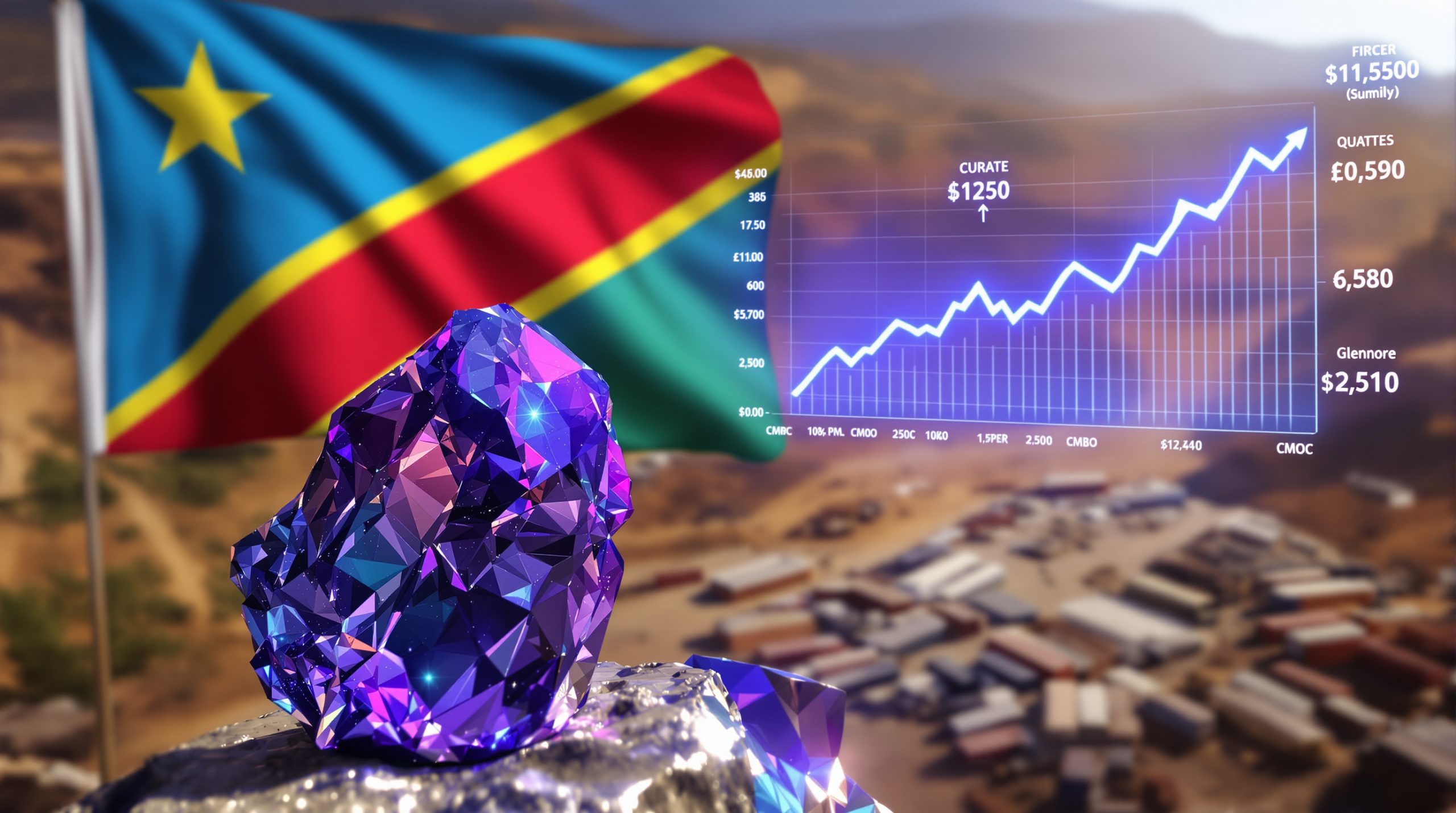What Makes a Mineral "Critical" in Today's Economy?
Critical minerals are defined by their essential role in economic and national security, vulnerability to supply disruptions, and importance in manufacturing and technology sectors. These resources are designated as "critical" when their absence would significantly impact a country's economy or defense capabilities.
For a mineral to qualify as critical, it typically must meet several key criteria:
-
Essential to key industries – Irreplaceable in strategic sectors like defense, energy, and technology
-
Supply chain vulnerability – Limited production sources, geopolitical risks, or processing constraints
-
Limited substitutability – Few or no viable alternatives with similar performance characteristics
-
Growing demand trajectory – Increasing importance in emerging technologies and green transition
Copper has historically occupied a unique position—universally recognized as essential but often not officially designated as "critical" on national strategic mineral lists. This status has begun to change as governments reassess copper as critical mineral in light of energy transition demands and evolving supply-demand dynamics.
How Does Copper Meet the Definition of a Critical Mineral?
Essential Role in Modern Infrastructure and Technology
Copper's exceptional electrical conductivity, thermal properties, and corrosion resistance make it irreplaceable in numerous applications:
-
Electrical systems: Power generation, transmission, and distribution infrastructure
-
Renewable energy: Solar panels (4-5 tons per MW), wind turbines (2.5-6 tons per MW)
-
Electric vehicles: 3-4 times more copper than conventional vehicles (83kg vs. 23kg)
-
Electronics: Circuit boards, microchips, and telecommunications equipment
-
Construction: Plumbing, wiring, roofing, and architectural elements
-
Industrial machinery: Motors, generators, and heat exchangers
The metal's versatility extends beyond these applications to critical defense systems, including naval vessels, aircraft, and communications technology—further cementing its strategic importance.
Supply Chain Vulnerabilities and Concentration Risks
Despite being more geographically distributed than some critical minerals, copper production faces several significant supply risks:
| Supply Risk Factor | Current Status |
|---|---|
| Geographic concentration | Chile (28%), Peru (10%), China (8%), DRC (8%), USA (6%) |
| Processing bottlenecks | China controls 40% of global refining capacity |
| Declining ore grades | Average grades fallen from 1.5% to below 0.7% in last century |
| Water constraints | 65% of production in water-stressed regions |
| Project development | 15+ year timeline from discovery to production |
| Investment shortfall | $100+ billion needed in new mine development by 2030 |
These vulnerabilities create potential chokepoints in the supply chain, particularly as demand increases for energy transition technologies and electrification across industries. Furthermore, the global copper supply forecast indicates growing concerns about meeting future needs.
Why Is the U.S. Adding Copper to Its Critical Minerals List?
The United States has recently proposed adding copper to its official Critical Minerals List, marking a significant policy shift. This decision reflects several converging factors and acknowledges copper's fundamental role in the economy.
Growing Supply-Demand Imbalance
The U.S. Geological Survey and industry analysts project a significant copper supply gap emerging:
-
Global demand expected to rise 40-50% by 2035
-
Current and planned mining capacity insufficient to meet projected needs
-
U.S. import reliance increasing, particularly for refined copper
-
Domestic production meeting only about 23% of U.S. consumption needs
As of August 2024, the U.S. has officially proposed adding copper to its critical minerals list, signaling recognition of these supply challenges and copper's strategic importance to the economy. According to the U.S. Department of Energy, copper is essential for the clean energy transition, appearing in nearly all energy-related technologies.
National Security Considerations
Defense applications require substantial copper inputs:
-
Naval vessels (20,000+ tons for aircraft carriers)
-
Military aircraft and vehicles
-
Communications infrastructure
-
Weapons systems
-
Ammunition components
The Department of Defense has identified reliable copper access as essential to military readiness and technological superiority, particularly as advanced defense systems require increasingly specialized materials.
Energy Transition Requirements
The clean energy transition dramatically increases copper intensity across the economy:
-
Grid modernization requires 439,000 tons of copper per year
-
EV charging infrastructure needs 12,000 tons per 1 million chargers
-
Renewable energy deployment demands 5-10x more copper than conventional power
Without secure copper supplies, climate goals become significantly more challenging to achieve, creating a strategic imperative for securing reliable supply chains. Many analysts are watching the copper price prediction trends closely as demand continues to grow.
What Are the Challenges Facing Copper Production?
Declining Ore Grades and Increasing Extraction Costs
Modern copper mining faces substantial challenges that affect production economics:
-
Grade deterioration: Average ore grades have declined from approximately 1.5% to below 0.7% over the past century
-
Deeper deposits: Easily accessible resources largely depleted, requiring deeper and more complex mining
-
Water constraints: Approximately 65% of copper production occurs in water-stressed regions
-
Energy intensity: Lower grades require more energy per ton of copper produced
-
Capital requirements: New mines typically cost $8-15 billion and take 15+ years to develop
These factors contribute to rising production costs and extended timelines for bringing new supply online, even as demand continues to grow. The South Australian government has recognized these challenges by officially declaring copper a critical mineral to encourage exploration and development.
Environmental and Social License Challenges
Copper mining faces increasing scrutiny regarding its environmental and social impacts:
-
Water usage: Processing one ton of copper typically requires 70-80 cubic meters of water
-
Waste management: Tailings storage and acid mine drainage present long-term challenges
-
Land disturbance: Open-pit mining creates significant landscape alterations
-
Community relations: Local opposition can delay or halt projects
-
Regulatory hurdles: Permitting timelines extending to 7-10 years in many jurisdictions
The industry must address these concerns while simultaneously increasing production to meet growing demand, creating a complex balancing act between environmental stewardship and resource development.
How Does Copper Compare to Other Critical Minerals?
Copper occupies a unique position among critical minerals due to its combination of essential applications, supply challenges, and massive volume requirements:
| Mineral | Annual Production | Key Applications | Supply Risk Level |
|---|---|---|---|
| Copper | 21 million tonnes | Electrical, construction, transport | Moderate-High |
| Lithium | 130,000 tonnes | Batteries, ceramics | High |
| Rare Earths | 280,000 tonnes | Magnets, electronics | Very High |
| Cobalt | 170,000 tonnes | Batteries, superalloys | High |
| Nickel | 2.7 million tonnes | Batteries, stainless steel | Moderate |
Unlike many other critical minerals, copper's criticality stems not from extreme scarcity but from the massive volumes required for the energy transition—with a single 500MW solar farm requiring over 2,500 tonnes of copper. As a result, gold and copper exploration efforts have intensified globally.
What Are the Implications of Copper's Critical Mineral Status?
Policy and Investment Impacts
The designation of copper as a critical mineral carries significant implications:
-
Streamlined permitting: Projects may qualify for expedited regulatory review
-
Investment incentives: Tax benefits and funding opportunities for domestic production
-
Strategic stockpiling: Potential inclusion in national defense stockpiles
-
Research funding: Increased support for extraction technologies and recycling
-
International agreements: Strategic partnerships to secure supply chains
These policy changes aim to accelerate domestic production and processing capacity while reducing import dependence and supply chain vulnerabilities. For investors, understanding various copper investment strategies has become increasingly important.
Market and Price Effects
Copper's critical designation may influence market dynamics:
-
Investor attention: Increased focus on copper mining equities
-
Price premiums: Potential for regional price differentials based on supply security
-
Long-term contracting: More emphasis on securing stable supply through agreements
-
Project financing: Improved access to capital for development projects
-
Vertical integration: Manufacturers may invest directly in mining assets
These effects could reshape industry structure and pricing mechanisms over time, potentially creating new market dynamics and investment opportunities.
How Are Major Mining Companies Responding to Copper's Critical Status?
Leading mining companies are accelerating copper project development in response to its growing strategic importance:
-
BHP: Investing $10 billion at Escondida but expecting flat production (0.9-1.0 million tons) for the next 5 years; shifting focus from Australian assets to South American projects
-
Rio Tinto: Developing the Resolution Copper project in Arizona despite environmental appeals and social challenges
-
Freeport-McMoRan: Expanding operations at Grasberg in Indonesia
-
Codelco: Implementing underground transition at Chuquicamata and El Teniente following safety concerns
-
Glencore: Shifting investment focus from Australia (closing Mount Isa operations) to Argentina with El Pachón project ($8.5-10.5 billion capex) and Agua Rica
These companies face the dual challenge of maintaining existing production while developing new projects with increasingly complex technical, environmental, and social considerations. Recent copper investment insights highlight the growing focus on Australian and Canadian resources.
Capital Intensity Considerations
The economics of new copper projects vary significantly:
-
El Pachón: Capital intensity of approximately $275,000 per ton of installed capacity
-
Agua Rica: Capital intensity of approximately $145,000 per ton (benefiting from existing infrastructure)
-
Marimaca Oxide Deposit: Pre-production capital cost of $587 million with capital intensity of $11,700 per ton
These figures illustrate the wide range of investment requirements and the critical importance of existing infrastructure in determining project economics.
What Role Does Recycling Play in Copper's Critical Mineral Status?
Recycling represents a crucial component of copper supply security:
-
Currently provides approximately 30% of annual copper supply
-
Requires 85% less energy than primary production
-
Produces significantly lower environmental impacts
-
Offers domestic supply in regions with limited mining potential
-
Faces challenges in collection, sorting, and processing technologies
Enhancing recycling rates could significantly reduce import dependence and environmental impacts while providing a more stable domestic supply source. However, even with maximized recycling, substantial new primary production will be required to meet growing demand.
What Does the Future Hold for Copper as a Critical Mineral?
Projected Supply-Demand Scenarios
Analysts project several potential futures for copper markets:
-
Base case: 4-6 million tonne annual deficit by 2035 without significant new mine development
-
Accelerated case: Deficit could reach 9-10 million tonnes if energy transition accelerates
-
Price response: Higher prices may stimulate additional production but with significant lag time
-
Substitution effects: Limited potential for replacement in key applications
-
Technology impacts: Mining innovations could unlock previously uneconomic resources
These scenarios highlight the strategic importance of securing copper supply chains through diversified sources, including domestic production, recycling, and international partnerships.
Strategic Implications for Nations and Industries
Copper's critical mineral status carries profound implications:
-
National security: Countries with secure copper access will maintain technological advantages
-
Energy transition: Climate goals depend on sufficient copper availability
-
Industrial competitiveness: Manufacturing sectors require reliable, affordable supply
-
Geopolitical leverage: Producing nations may gain strategic influence
-
Innovation drivers: Scarcity may accelerate technological development in efficiency and substitution
These factors will shape international relations, industrial policy, and technological development for decades to come.
Why Copper's Critical Status Matters
Copper's designation as a critical mineral represents more than a regulatory classification—it signals a fundamental shift in how governments and industries view this essential metal. As the foundation of electrical systems, renewable energy, and transportation electrification, copper's availability directly impacts economic security, defense capabilities, and climate goals.
The challenges facing copper supply—declining grades, water constraints, and lengthy development timelines—create genuine risks to future availability at the scale required for modern economies. By recognizing copper as critical mineral, policymakers acknowledge these vulnerabilities and create frameworks to address them through investment, innovation, and international cooperation.
For industries dependent on copper, this designation highlights the importance of supply chain resilience, recycling, and resource efficiency. For consumers, it underscores the material foundations of modern technologies and the complex global systems that deliver them.
As the energy transition accelerates, copper's role as a critical mineral will only grow in importance, making today's policy decisions and investment choices crucial determinants of tomorrow's technological and environmental possibilities.
Disclaimer: This article contains market analysis and investment-related information. Commodity markets and mining investments involve significant risk. Readers should conduct their own research and consider consulting with financial advisors before making investment decisions.
Ready to Spot the Next Major Mineral Discovery?
Discover why critical minerals like copper are driving exceptional returns for early investors with Discovery Alert's proprietary Discovery IQ model, which instantly analyses ASX announcements to identify significant mineral discoveries before the broader market. Explore historic examples of transformative discoveries and their market impact at Discovery Alert's dedicated discoveries page and begin your 30-day free trial today.




